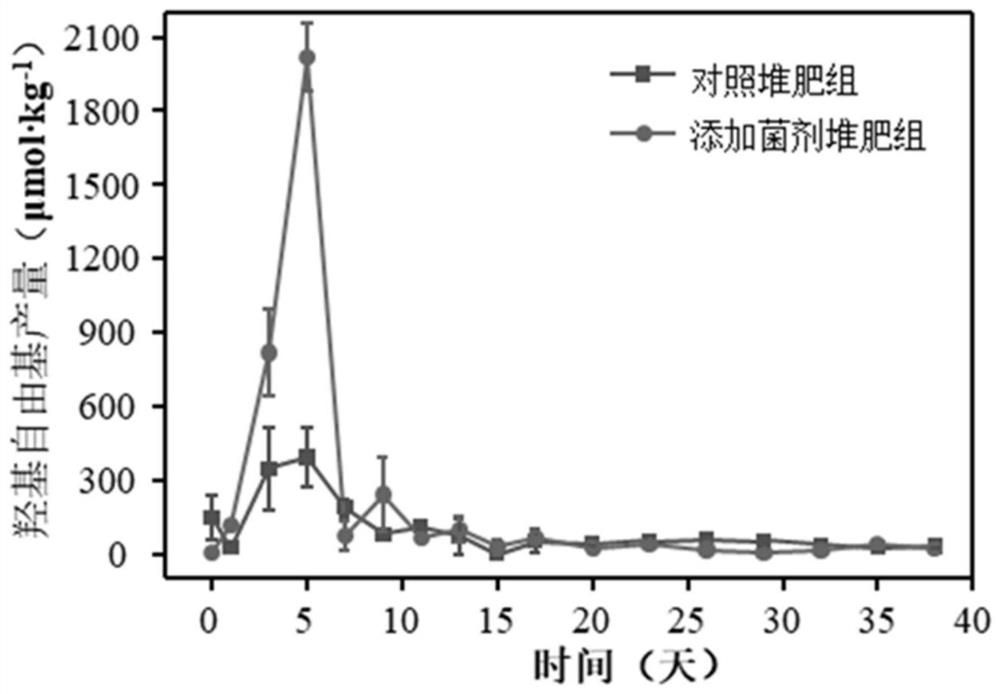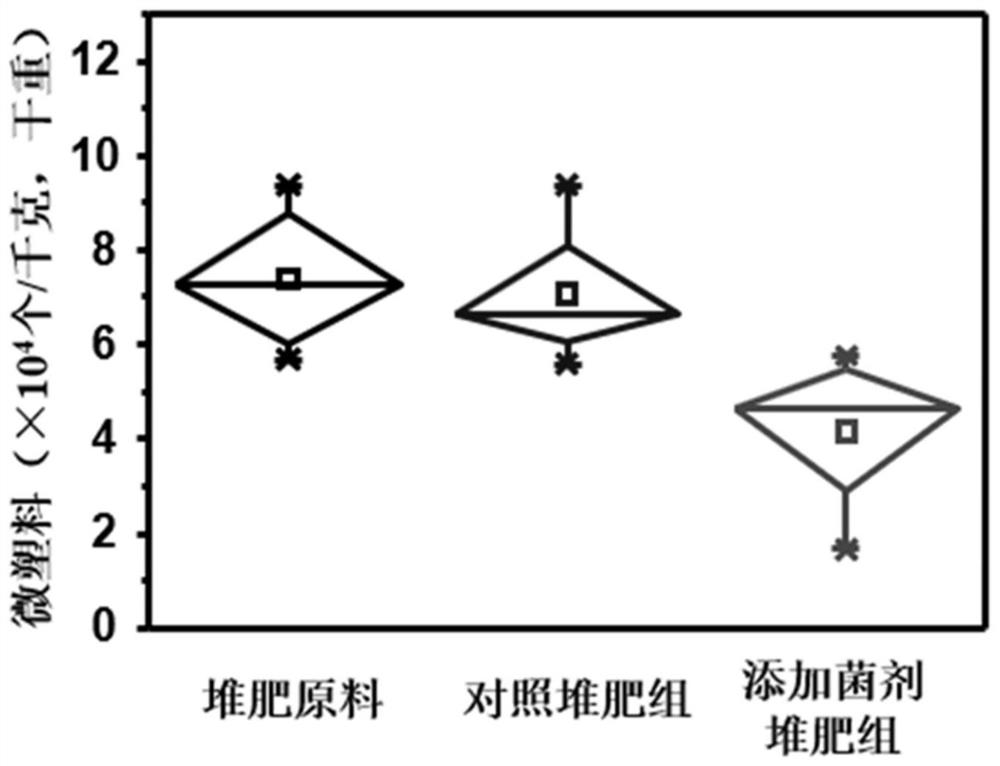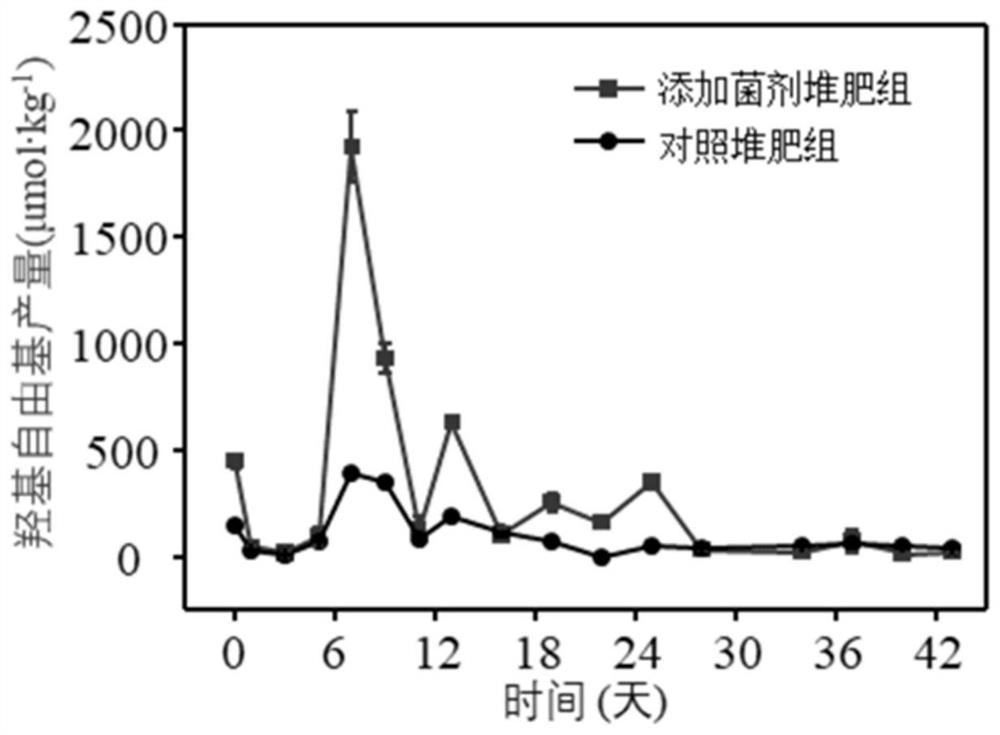Composite high-temperature microbial inoculum and application thereof in plastic degradation
A high-temperature bacteria and plastic technology, applied in the field of environmental purification, can solve the problems of low degradation rate and inability to remove microplastics, achieve efficient removal and broaden the application range
- Summary
- Abstract
- Description
- Claims
- Application Information
AI Technical Summary
Problems solved by technology
Method used
Image
Examples
Embodiment 1
[0057] The preparation of embodiment 1 composite high-temperature bacterial agent
[0058] The preparation method is as follows:
[0059] (1) Preparation of seed solution:
[0060] According to the inoculum size of 2%, the concentration is 10 8 Cfu / mL of Bacillus composti SgZ-9 bacteria liquid is inoculated into the container with LB medium, and fermented at 50°C for 48 hours. During the fermentation process, air needs to be introduced, and the ventilation rate is 20-100m 3 / h, and continuously stirred at a speed of 180-220 rpm, and the Bacillus composti SgZ-9 seed liquid was obtained after the fermentation was completed.
[0061] (2) Preparation of anaerobic fermentation medium:
[0062] Mix 0.6g / L sodium dihydrogen phosphate, 0.25g / L ammonium chloride, 0.1g / L potassium chloride, 0.2g / L yeast extract (yeast powder, purchased from Aladdin), 0.5g / L glucose, Add 3% (mass ratio) ferrihydrite, adjust the pH to 7.0, and stir evenly. Pass nitrogen / carbon dioxide mixed gas into ...
Embodiment 2
[0065] The preparation of embodiment 2 composite high-temperature bacterial agents
[0066] The preparation method is as follows:
[0067] (1) Preparation of seed solution:
[0068] According to the inoculum size of 2%, the concentration is 10 8 Cfu / mL of Bacillus thermophilus SgZ-10 bacteria liquid is inoculated into the container with LB medium, and fermented at 50°C for 48 hours. During the fermentation process, air needs to be introduced, and the ventilation rate is 20-100m 3 / h, and continuously stirred at a speed of 180-220 rpm, and the Bacillus thermophilusSgZ-10 seed liquid was obtained after the fermentation was completed.
[0069] (2) Preparation of anaerobic fermentation medium:
[0070] Mix 0.6g / L sodium dihydrogen phosphate, 0.25g / L ammonium chloride, 0.1g / L potassium chloride, 0.2g / L yeast extract (yeast powder, purchased from Aladdin), 0.5g / L glucose, Add 5% (mass ratio) hematite, adjust the pH to 7.5, and stir evenly. Pass nitrogen / carbon dioxide mixed gas...
Embodiment 3
[0073] The preparation of embodiment 3 composite high-temperature bacterial agents
[0074] The preparation method is as follows:
[0075] (1) Preparation of seed solution:
[0076] According to the inoculum amount of each 2% of each plant, the concentration was 10 8 cfu / mL of Bacillus composti SgZ-9 bacteria solution and a concentration of 10 8 Cfu / mL of Bacillus thermophilus SgZ-10 bacteria solution was inoculated into the container with LB medium respectively, and fermented at 50°C for 24 hours. During the fermentation process, air was required, and the ventilation rate was 20-100m 3 / h, and continuously stirred at a speed of 180-220 rpm, after the fermentation is completed, Bacillus composti SgZ-9 and Bacillusthermophilus SgZ-10 seed liquids are obtained.
[0077] (2) Preparation of anaerobic fermentation medium:
[0078] Mix 0.6g / L sodium dihydrogen phosphate, 0.25g / L ammonium chloride, 0.1g / L potassium chloride, 0.2g / L yeast extract (yeast powder, purchased from Alad...
PUM
| Property | Measurement | Unit |
|---|---|---|
| size | aaaaa | aaaaa |
Abstract
Description
Claims
Application Information
 Login to View More
Login to View More - R&D Engineer
- R&D Manager
- IP Professional
- Industry Leading Data Capabilities
- Powerful AI technology
- Patent DNA Extraction
Browse by: Latest US Patents, China's latest patents, Technical Efficacy Thesaurus, Application Domain, Technology Topic, Popular Technical Reports.
© 2024 PatSnap. All rights reserved.Legal|Privacy policy|Modern Slavery Act Transparency Statement|Sitemap|About US| Contact US: help@patsnap.com










